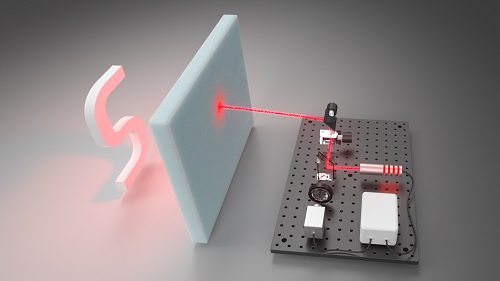
Lidar System Delivers Vision Through Clouds and Fog
Using a single-photon avalanche diode that can detect the arrival times of photons down to a single photon, with precision in the tens of trillions of seconds, researchers at Stanford University have developed a lidar system capable of seeing through opaque objects. The technology has potential for self-driving vehicles and satellite imaging.
In terms of timing resolution, the method surpasses most detectors in sensitivity and accuracy, said David Lindell, a graduate student in electrical engineering and lead author of the paper introducing the development.
“Like other lidar systems, it uses a laser to illuminate a point with a short pulse of light and then an ultrafast detector measures the time it takes for photons to scatter back,” Lindell said.

A three-dimensional reconstruction of the reflective letter S, as seen through the 1-in.-thick foam. Courtesy of Stanford Computational Imaging Lab.
Conventional lidar uses that time delay to measure the distance to an object, but that assumes that the photons traveled on a direct path to the object and back.
“Our system is specifically designed to measure and process the arrival times of photons that travel on indirect, scattered paths through scattering media to a hidden object and back,” Lindell said.
As the laser scans an obstruction, such as a wall of foam, some photons will pass through and bounce off of a hidden object and return through the foam to the detector. The algorithm-supported software then interprets the information — when and where the photons hit the detectors — to reconstruct the hidden objects in 3D.
“A major challenge in imaging objects through scattering media is that most photons that are emitted by our laser do not scatter back to the detector. We only measure those photons that scatter the media, are reflected by an object, and scatter back,” Lindell said.
For bright reflective objects like traffic cones or road signs, the system is able to provide information in under a minute. For dimmer objects that are less reflective, it can take up to an hour to collect enough photons.
“However there are a few potential ways that the system could be made faster,” Lindell said. “While we only had a green laser available for our prototype, moving to longer wavelengths of infrared would result in less scattering, more returning photons, and faster acquisition.”
It may also be possible to further improve the algorithms to be more robust to lower numbers of captured photons and shorter acquisition times, Lindell said.
“We are excited to push this further with other types of scattering geometries,” he said. “So, not just objects hidden behind a thick slab of material, but objects that are embedded in densely scattering material, which would be like seeing an object that’s surrounded by fog.”
The research was published in Nature Communications (www.doi.org/10.1038/s41467-020-18346-3).
Published: September 2020